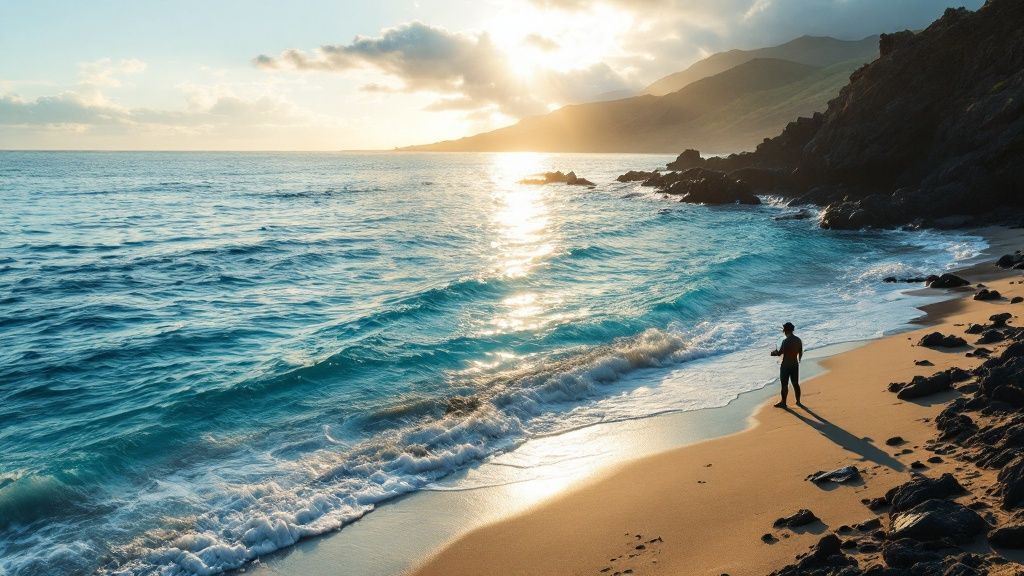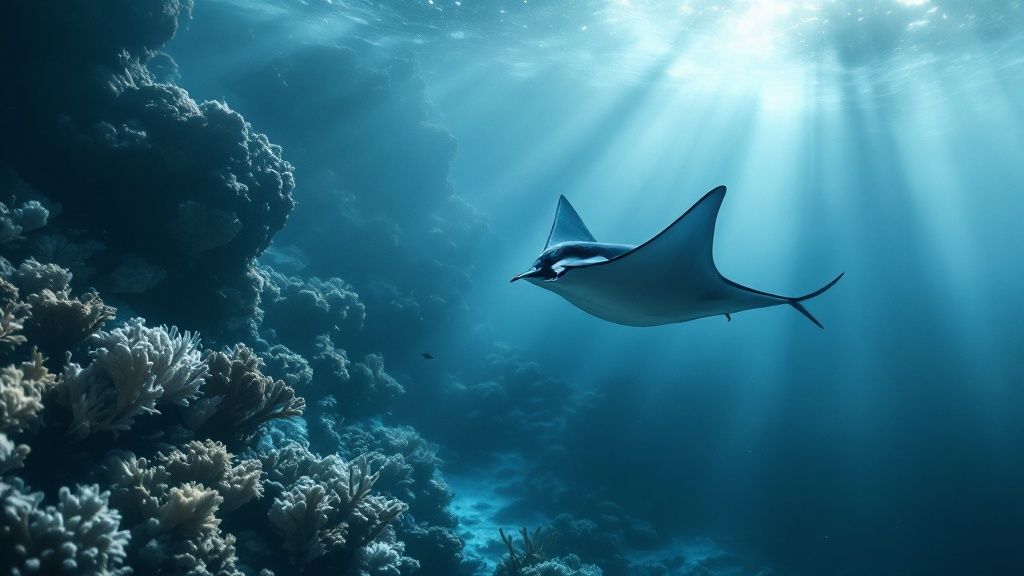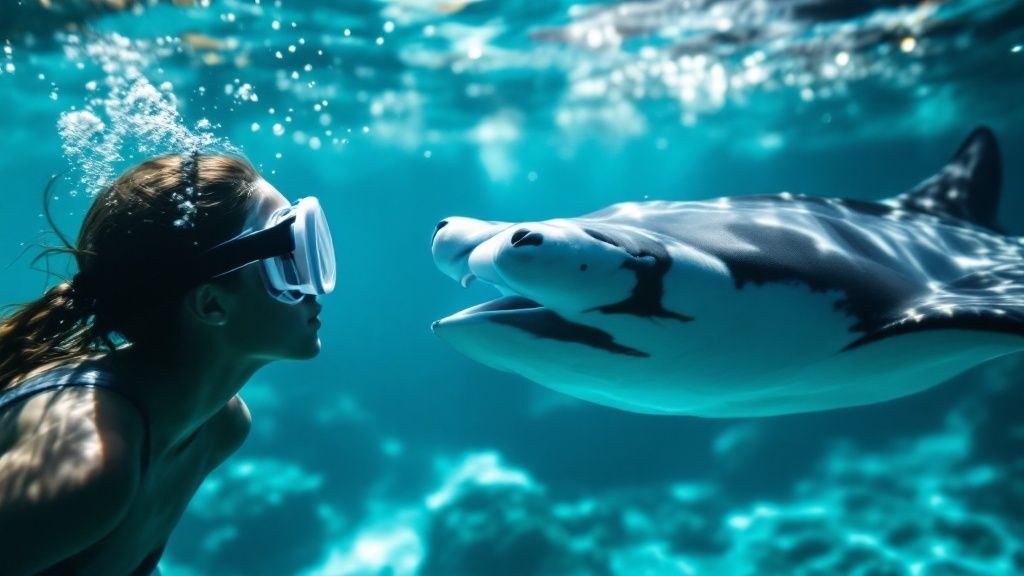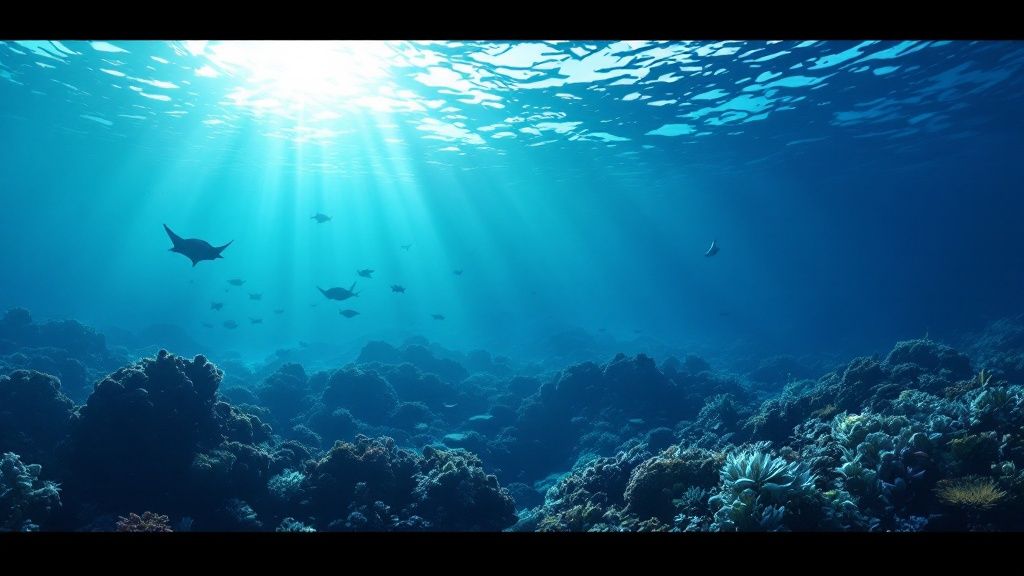Manta Ray Snorkel Big Island: Ultimate Adventure
- Byron
- Mar 5
- 11 min read
The Magic of Manta Ray Encounters on Hawaii's Big Island

The Big Island of Hawaii offers a truly special experience: the chance to snorkel with manta rays at night. This activity draws visitors worldwide eager to see these gentle giants in their natural habitat. For many, a manta ray snorkel Big Island adventure is a trip highlight. But what makes this location a haven for these creatures?
One key factor is the abundance of plankton, the manta ray's main food source. The nutrient-rich waters around the Big Island are ideal for plankton, which in turn attracts large numbers of manta rays. These gentle giants, with wingspans reaching up to 14 feet, gracefully glide through the water, filtering plankton.
The unique topography of the Kona Coast also plays a vital role. Sheltered bays, like Keauhou Bay (Manta Village), offer calm, clear waters perfect for observation. The relatively shallow depths enhance visibility, creating amazing up-close encounters. This accessibility makes the experience suitable for various skill levels.
Why is the Big Island Such a Hotspot for Manta Rays?
Manta ray snorkeling on the Big Island has grown in popularity, attracting diverse participants. This activity is thrilling and educational, teaching snorkelers about the local ecosystem and responsible tourism. The experience involves swimming with manta rays at night, using lights to attract phytoplankton, which the mantas then follow. This ensures safe, ecologically responsible interaction.
Since new legislation in 2020 banned close dolphin encounters, manta ray tours have become a popular alternative for engaging with marine life. Learn more about this phenomenon here.
Why Choose a Manta Ray Snorkel Big Island Tour?
While tempting to find manta rays independently, guided tours enhance the experience. Experienced guides know the best viewing spots and provide valuable insights into manta ray behavior and biology. They also ensure safety and the well-being of the manta rays by enforcing responsible practices.
This once niche experience has become a signature Hawaiian adventure. Booking a manta ray snorkel Big Island tour offers a unique, unforgettable way to connect with the marine world. You witness a breathtaking natural phenomenon and contribute to sustainable tourism that protects these incredible animals.
Prime Locations for Unforgettable Manta Ray Encounters

The Kona Coast is famous for its incredible manta ray snorkeling opportunities. Within this area, a few spots truly shine for consistently amazing encounters. Two favorites are Manta Village (Keauhou Bay) and Manta Heaven (Garden Eel Cove), each offering a unique experience.
Manta Village, nestled in Keauhou Bay, is known for its calm, shallow waters. This makes it perfect for beginners and families. The bay’s sheltered nature creates a comfortable environment, even for those who aren’t strong swimmers. The shallow depth also means fantastic visibility, often allowing for spectacular up-close manta ray views.
Manta Heaven, near the airport in Garden Eel Cove, provides a different adventure. While still accessible, this spot typically has slightly deeper water and can have more current. For experienced snorkelers looking for a bit more excitement, Manta Heaven is a great choice. The increased depth and current can attract larger groups of manta rays.
An estimated 80,000 people snorkel and dive with manta rays on the Big Island each year. This makes it a highly sought-after activity, contributing significantly to local tourism. Two manta ray species, the reef manta ray (Mobula alfredi) and the giant manta ray (Mobula birostris), are frequently seen. For more detailed statistics, check out this article: 10 Things You May Not Know About Manta Rays in Hawai’i.
Seasonal Considerations for Manta Ray Snorkel Big Island Adventures
Timing your trip right can further enhance your manta ray experience. While manta rays are present year-round, the best viewing conditions are usually during the dry season (April to October). During this time, the waters are clearer and calmer, improving visibility.
Each location, however, responds differently to seasonal shifts. Manta Village might offer more predictable encounters during the winter months because of its sheltered position. Manta Heaven, on the other hand, might be better during the summer when plankton blooms attract more manta rays. For additional insights, visit Our blog post sitemap.
Choosing Your Ideal Manta Ray Snorkel Big Island Location
The best location for your manta ray snorkel tour ultimately depends on your preferences and experience. Think about your comfort level in the water, how close you want to get to the manta rays, and how much excitement you’re seeking.
To help you choose, here’s a comparison of the two locations:
Manta Ray Snorkel Locations Comparison
Location | Best For | Average Depth | Typical # of Mantas | Boat Access | Shore Access |
|---|---|---|---|---|---|
Manta Village (Keauhou Bay) | Beginners, families | Shallow | Varies, often smaller groups | Yes | Limited |
Manta Heaven (Garden Eel Cove) | Experienced snorkelers | Deeper | Varies, potential for larger groups | Yes | No |
This table highlights the key differences between the two locations, making it easier to choose the right spot for your adventure. Manta Village is ideal for those new to snorkeling or who prefer calmer waters. Manta Heaven is a better fit for more experienced snorkelers looking for the possibility of larger manta ray gatherings.
By understanding the characteristics of each location and considering the time of year, you can make informed decisions and maximize your chances of an unforgettable manta ray encounter.
Selecting Your Perfect Manta Ray Experience

With so many Big Island tour operators offering manta ray snorkel trips, picking the right one can make all the difference. Your choice impacts not only your enjoyment but also the well-being of these gentle giants. So, how do you separate the truly outstanding operators from the rest?
One key factor is the operator's dedication to sustainable practices. Look for certifications and eco-credentials, but go further. Ask about their specific conservation efforts. Do they participate in research or contribute to local initiatives? True commitment extends beyond simple marketing. A responsible manta ray snorkel experience benefits both the visitor and the environment.
Key Questions to Ask Your Tour Operator
Asking the right questions can unveil an operator's true commitment to responsible tourism. Inquire about their group sizes and guide-to-snorkeler ratios. Smaller groups provide more personalized attention and minimize disturbance to the manta rays. A lower guide-to-snorkeler ratio ensures better supervision, improving safety for both you and the mantas.
Also, ask about their “manta ray guaranteed” policy. This shows their dedication to providing a valuable experience, even if nature doesn't fully cooperate on your chosen night.
Deciphering Premium vs. Marketing Pricing
A higher price doesn't automatically mean a better manta ray snorkel experience. Understand what justifies higher costs. Does it cover specialized equipment, expert guides, or donations to conservation efforts? Or is it just clever marketing?
Sometimes, a moderately priced tour with a strong conservation focus can be far more rewarding than an expensive option lacking a real commitment to sustainability. Careful research is crucial for maximizing your experience while promoting responsible tourism.
Ensuring Quality and Comfort: Equipment and Practices
The quality of equipment is another vital aspect. Ask about the types of wetsuits provided and the condition of the snorkeling gear. Properly fitting, well-maintained equipment ensures your comfort and safety during your adventure.
Also, inquire about their lighting techniques. Responsible operators use lights strategically to attract plankton while minimizing disruption to the manta rays’ natural behavior. The economic impact of manta ray tourism is substantial, with over 10,000 annual visitors generating over $4 million for Hawaii's economy. This underscores the need for sustainable practices. Learn more about the economic impact of manta ray tours here.
Making Informed Choices for an Unforgettable Experience
By asking the right questions and doing your research, you can select a manta ray snorkel tour that aligns with your values and delivers an enriching experience. A truly memorable encounter respects these magnificent creatures and contributes to their long-term well-being. This careful selection ensures your Big Island manta ray snorkel adventure is more than just a tourist activity; it becomes a meaningful connection with the ocean’s gentle giants.
Your Night With Majestic Ocean Giants: What to Expect

A manta ray snorkel Big Island adventure is more than just a quick dip in the ocean. It's a well-planned experience designed for both your safety and the best possible viewing. From the moment you step onto the harbor, your tour operator will guide you through every detail, ensuring you're fully prepared for this incredible encounter.
You'll begin with a comprehensive briefing, covering everything from how to properly fit your wetsuit (crucial for staying warm in Hawaiian waters) to specific night snorkeling techniques. This preparation is key for making the most of your manta ray experience.
Embarking on Your Big Island Manta Ray Journey
Once you're on the boat, a short trip will take you to the chosen snorkel site. Guides often select locations known for manta ray activity, such as Manta Village, increasing your chances of a truly memorable sighting. Here, they deploy special lights to attract plankton, the manta rays' primary food source. This creates an enticing "manta ray buffet," drawing these gentle giants closer to the surface.
Upon entering the water with your flotation devices and snorkel gear, you’ll be instructed to hold onto a submerged board. This provides a stable viewing platform and minimizes disturbance to the manta rays’ feeding.
Witnessing the Manta Ballet: An Up-Close Encounter
Get ready to be amazed as the manta rays glide below you, performing their graceful feeding ballet. These magnificent creatures, with wingspans reaching up to 14 feet, will come remarkably close. Remember, however, to avoid touching them, as this can harm their delicate mucous layer.
Experienced guides carefully manage the entire experience, making sure everyone has a great view while prioritizing the manta rays' well-being. They'll also share interesting facts about the manta rays' behavior and biology throughout your tour.
Understanding Seasonal Variations and Tour Expectations
To help you choose the best tour for your needs, here's a comparison of different options:
Manta Ray Snorkel Tour Comparison: Key differences between budget, standard and premium manta ray tours
Tour Type | Average Cost | Group Size | Equipment Quality | Amenities | Duration |
|---|---|---|---|---|---|
Budget | $100 - $150 | 10-20 people | Basic | Snorkel gear, flotation devices | 20-30 minutes in water |
Standard | $150 - $200 | 6-12 people | Good | Snorkel gear, flotation devices, light snacks and drinks | 30-45 minutes in water |
Premium | $200+ | 4-8 people | Premium | High-quality snorkel gear, wetsuits, flotation devices, hot beverages, snacks, photos/videos | 45-60 minutes in water |
As you can see, tour prices and inclusions vary. Choosing the right tour depends on your budget and desired level of comfort.
The time you’ll actually spend in the water with the manta rays typically lasts 20-30 minutes. This, along with water clarity and the number of manta rays present, can vary depending on the season. While mantas are present year-round, calmer waters and increased plankton blooms during the summer months often create longer and more vibrant encounters.
Manta ray snorkel Big Island tours truly offer a magical experience. Understanding the process and having realistic expectations will ensure you’re fully prepared to appreciate the wonder of these gentle giants. This knowledge transforms a simple snorkeling trip into a profound connection with some of the ocean's most captivating creatures.
The Science Behind Your Manta Ray Encounter
Your manta ray snorkel Big Island experience offers more than just an incredible adventure. It provides a unique glimpse into the fascinating world of scientific discovery surrounding these gentle giants. Behind the scenes, researchers dedicate their efforts to understanding these creatures and ensuring their continued survival. Your tourism dollars play a vital role in supporting these crucial conservation efforts.
Identifying and Tracking Manta Rays
One of the most remarkable aspects of manta ray research is the method used to identify individual animals. Much like human fingerprints, each manta ray possesses a unique pattern of spots on its belly. Researchers cleverly refer to these as "belly prints." These unique markings are used to track individual manta rays over time, providing insights into their movements, behaviors, and life histories.
Imagine recognizing a friend in a crowded room simply by their face. That's essentially what researchers do with manta rays. By meticulously cataloging these unique markings, scientists build a comprehensive database. This database becomes a treasure trove of valuable information about the manta ray population.
This identification process allows researchers to monitor feeding behaviors and migration routes. They can determine how far individual manta rays travel, their preferred feeding areas, and how their movements relate to environmental influences like ocean currents and plankton blooms. This knowledge forms the foundation for designing effective conservation strategies.
Data Collection in Hawaii
The collection of data on manta rays in Hawaii is a collaborative undertaking involving local researchers and tour operators. Between 2009 and 2014, comprehensive data was gathered on manta ray sightings at well-known dive sites like Manta Village and Manta Heaven. This data included identifying individual manta rays, tracking their frequency of appearance, and correlating sightings with lunar phases. The collection process relied on a team of experienced videographers and divemasters who meticulously reviewed footage and shared sighting notes. This collaborative approach ensures the accuracy of manta ray identification and counting. You can find more detailed statistics on this process here.
Understanding Manta Ray Reproduction and Challenges
Researchers are also focusing on understanding manta ray reproductive cycles. They are studying their mating behaviors, gestation periods, and pupping grounds, all crucial for protecting vulnerable young manta rays and ensuring the long-term health of the population. These studies contribute to a more comprehensive understanding of the manta ray life cycle, enabling scientists to pinpoint critical stages where conservation efforts can be most effective.
Despite the ongoing research, Hawaii's manta ray population faces substantial environmental challenges. Pollution, habitat degradation, and entanglement in fishing gear all threaten their survival. Understanding these challenges is the first step towards developing and implementing effective solutions. You can find more related articles on our blog categories sitemap.
Responsible Tourism and Citizen Science
Fortunately, responsible manta ray snorkel Big Island tourism has emerged as a key player in conservation efforts. By participating in well-managed tours, you directly contribute to research and support sustainable practices. Your presence can genuinely benefit the manta rays. This transforms your manta ray snorkel Big Island adventure from a simply fun experience into a valuable contribution to the protection of these magnificent creatures.
Furthermore, many tours incorporate elements of citizen science. This means you can actively participate in data collection and contribute to ongoing research efforts. This might involve taking photos of manta ray belly prints, recording behavioral observations, or even participating in tagging programs.
By engaging in citizen science, you become an active participant in expanding our knowledge of these enigmatic ocean ambassadors. This interactive element adds another layer of meaning to your manta ray snorkel Big Island experience, making your vacation an opportunity to make a real difference.
Insider Techniques for Manta Ray Encounter Excellence
Positioning yourself strategically in the water can dramatically improve your manta ray viewing experience during a manta ray snorkel Big Island tour. Beyond the basic instructions from your tour guides, a few simple techniques can maximize your chances of witnessing graceful manta passes right in front of you.
Body Positioning for Optimal Manta Ray Viewing
Maintaining a horizontal position in the water minimizes disturbances and allows the manta rays to approach closer. Think of yourself as floating like a raft – your body should be as flat and still as possible, allowing the mantas to glide beneath you undisturbed. Avoid sudden movements or kicking, which can frighten the manta rays and cause them to swim away.
Maintain a horizontal position: Imagine yourself as a piece of driftwood, letting the mantas pass underneath.
Minimize splashing: Keep your hands and feet still to reduce noise and movement.
Resist the urge to chase: Let the manta rays come to you. Forcing an interaction disrupts their natural behavior and diminishes your viewing experience.
This approach creates a calmer, more natural environment, encouraging the manta rays to approach. Check out the sitemap for more tips on preparing for your manta ray encounter.
Breathing Techniques for Close Encounters
Controlled breathing is crucial, especially when these large creatures pass close by. It's natural to feel excited, but rapid breathing creates unnecessary splashing and can make you more buoyant, interfering with your horizontal position. Focus on slow, deep breaths, similar to meditation or yoga breathing. This helps you stay calm and relaxed, allowing you to fully appreciate the magical moment.
Slow, deep breaths: This promotes relaxation and minimizes splashing.
Exhale slowly: Avoid releasing large bursts of air, which disturb the water's surface.
Practice beforehand: Get comfortable with these breathing techniques before your snorkel, especially if you are prone to nervousness in the water.
Underwater Photography Tips for Low-Light Conditions
Capturing stunning photos of manta rays in low light requires some finesse. Most manta ray snorkel Big Island adventures occur at night, presenting unique challenges for photography. With the right techniques, however, you can capture the magic of these encounters. For instance, a higher ISO setting on your camera compensates for the low light.
High ISO: This increases your camera's sensitivity to light, but be aware of potential noise in your images.
Fast shutter speed: Try to freeze the manta ray's motion with a speed of at least 1/250s, if your camera allows.
Red filter: A red filter, if compatible with your camera, can help compensate for the blue cast common in underwater photography.
Manta ray snorkel Big Island encounters are truly magical. By mastering these techniques, you'll enhance your viewing experience and create lasting memories. Remember to respect these magnificent creatures and their environment during your adventure. Book your Manta Ray Night Snorkel Kona Hawaii Tour today!
Comments